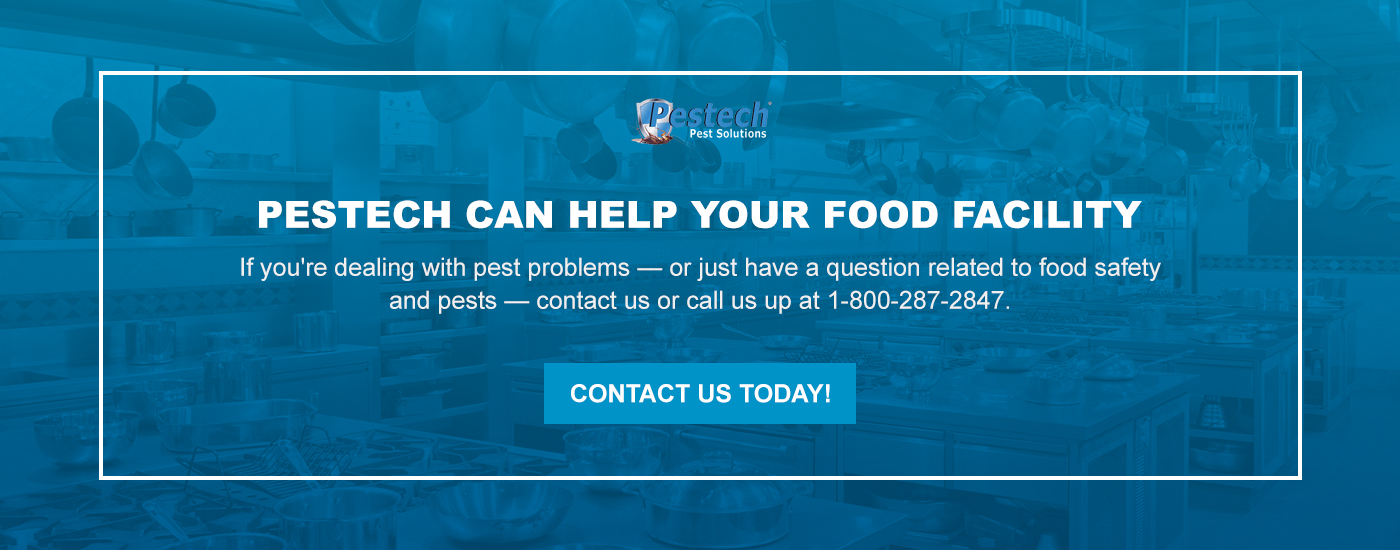Food Safety With Pest Control
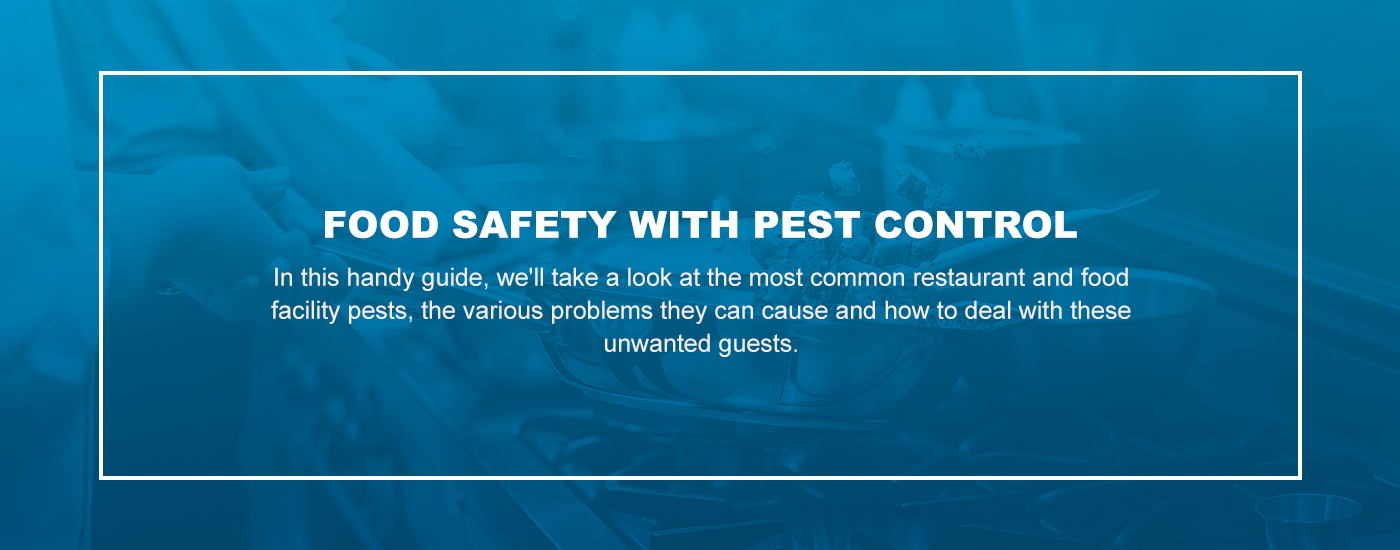
As pests are naturally attracted to food, the food industry is particularly vulnerable to pest infestations. And as pests pose a number of threats to food preparation facilities, including food contamination, the transmission of disease and property damage, food businesses need proper pest control.
In this handy guide, we’ll take a look at the most common restaurant and food facility pests, the various problems they can cause and how to deal with these unwanted guests.
Types of Pests in Food Facilities
The types of pests you deal with often depend on climate, geography and the food ingredients you work with. But there are some pests that are found practically everywhere in the world and in most food industries. These pests include:
Cockroaches
The cockroach is one of the most universally hated pests, and for a good reason. They’re known to carry a variety of parasitic worms, bacteria and human pathogens, which include salmonella Typhimurium, polio and Entamoeba histolytica. Cockroach legs often pick up germs and debris while traveling through unclean places. They can then transfer that to workstations, food and equipment used for food processing, which increases the risk of contamination.
Cockroaches are also good at hiding in tiny crevices, making them sometimes hard to spot. They also have a varied diet, allowing them to find viable food sources in different environments.
Rodents
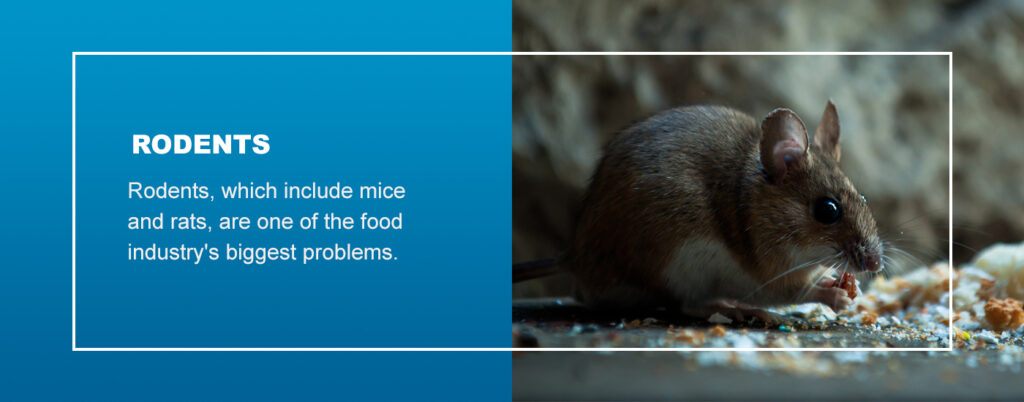
Rodents, which include mice and rats, are one of the food industry’s biggest problems. There are various ways to identify an infestation, which include visual sightings, droppings, gnawing noises and gnawed wires and insulation. You can also identify them by their urine stains, which can be seen under UV light.
They build their nests near food sources and are well-known for their ability to breed quickly. Rodent infestations pose many risks, including damage to electrical equipment, food containers, machinery and packaging. Their droppings, urine and fur can also transmit hazardous parasites to food, which increases the risk of employees and customers contracting serious diseases. Mice and rats are known to spread more than 35 diseases.
Flies
Flies are known to carry numerous harmful pathogens. They tend to breed in decaying trash and other moist, unsanitary environments then move on to fresh food and food processing equipment, contaminating them with harmful bacteria in the process. When they feed, flies pick up contaminated material, with some species regurgitating their digestive juices and defecating when resting and feeding, which causes further contamination.
Birds
Birds can do significant physical damage to your facility by building nests in gutters, which interfere with the drainage of water from your roof. Bigger species can also dislodge roof tiles. They can contaminate your food, food processing equipment and preparation areas, as well.
Bird droppings, apart from being unsightly, are also toxic and can transmit disease-causing pathogens like viruses, bacteria, fungi and protozoa. Common harmful microorganisms transmitted by birds include E. coli, salmonella and campylobacter, a common foodborne illness. Birds’ nesting and roosting sites also attract bird mites, fleas and certain beetle species.
Ants
Ants, due to their small size, can enter through extremely tiny openings, making them able to get into practically any facility. Once they have invaded a facility, ants will leave behind an invisible pheromone trail, which other members of their colony will follow. They can also invade and contaminate any source, effectively destroying it.
Spiders
While many spiders do not pose a health hazard, most are very unwelcome and cause fear or disgust in those who see them. Common signs of spider infestations include:
- Webs: While many species of spiders create geometric webs, others just make messy dens for trapping insects in more secluded places.
- Egg sacs: The majority of spider species lay eggs wrapped in a ball of silk, often hundreds at a time. If you spot these in or near your facilities, there’s a good chance they will hatch, resulting in more spiders wandering around your facility.
- Excess flying insects: If you’re spotting lots of flies, moths, mosquitos and other small flying insects in and around your facility, they may be attracting spiders to your property since they’re a food source.
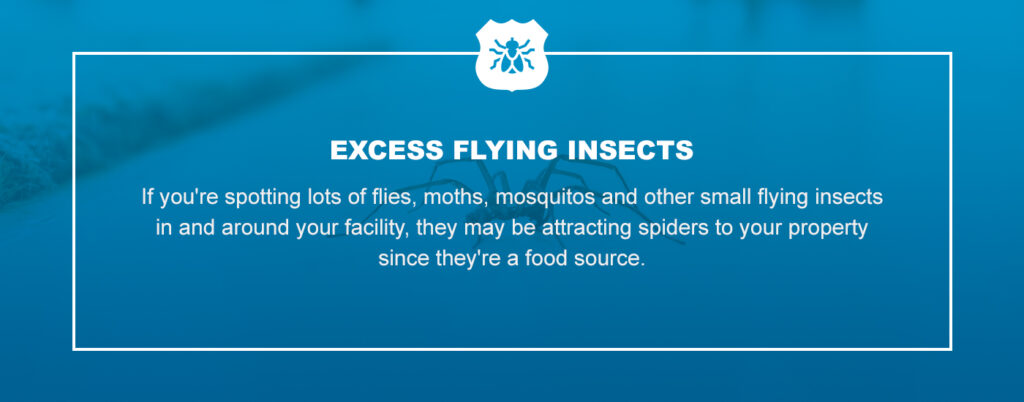
Why Pest Control in the Food Industry Is Important
Pests are a nuisance in all facilities, but it is perhaps in food preparation settings that they pose the greatest threat. Some of these threats include:
- They spread disease: Many pests are known to cause various health issues. Rodents can transmit salmonellosis, hantavirus and other serious diseases. Cockroaches can trigger allergy symptoms and asthma.
- They damage property: Many pests will do damage to your equipment and other property. Examples of damage include boring holes through food containers and walls and chewing electrical wires, which can cause significant economic loss.
- They contaminate food: Pests can contaminate food products as well as workstations, which puts the health of employees and customers at risk.
- They can damage your reputation: Seeing a cockroach running across the floor or flies in the kitchen will create a negative impression regarding how you handle food. Customers who spot pests in your establishment will have less trust in you, and if word gets around, the health inspector may be paying you a visit.
- They can lead to the closure of your business: If you do not deal with your pest infestation properly, your business may be shut down temporarily or permanently.
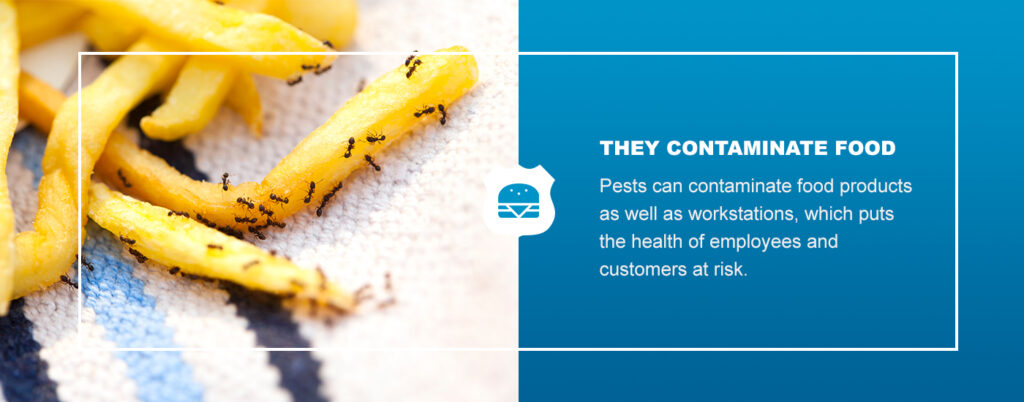
What Problems Can Pests Cause for Food Businesses?
Pests can cause a number of serious problems, especially in a food facility. These problems include:
- Physical damage: If a pest infestation is not handled properly, physical damage to your property can result. Pests can cause damage to food ingredients stocked in the kitchen, which of course will have to be thrown away, as well as your containers and kitchen equipment. If you have a rodent infestation, they can even break your cutlery or tools and chew your electrical wiring, which will further add to your financial losses.
- Loss of employees: A pest-infested kitchen can be hazardous to employees working there. The pests can carry diseases, which might cause your employees to become ill. More employees will then take time off of work, and you could eventually experience an employee shortage. Other employees may also quit their job to avoid getting sick and find a job with cleaner, more hygienic working conditions.
- Loss of customers: If your facility is unhygienic and unclean, customers will know when they eat their meal or potentially later if they contract health issues. It’s not hard to understand how a customer who gets sick off your food won’t want to give your restaurant or brand a second chance. Keep in mind that customers can also sue you for serving them unhealthy or contaminated food.
- Damaged reputation: Customers who’ve had a negative experience at your restaurant or with your food brand — whether it’s getting sick or finding a pest in their meal — will tell others about it. Bad word of mouth travels fast all over, which can severely damage or outright ruin your business’s reputation. A damaged reputation is not good for any business, as customers will no longer visit, further leading to significant losses. It may then take time to clean your facilities and regain a positive reputation.
- Prosecution: If your restaurant or food facility has a bad reputation, this will ultimately reach officials, which is even riskier for your establishment. If officials hear of unhygienic conditions and come to perform an inspection of your kitchen, they can give you a hefty fine if they find your kitchen is not in accordance with the rules. Following the inspection, if you fail to eliminate the pests from your kitchen, these officials can file a case against you, leading to your business closing.

From economic losses to legal trouble, neglecting pest control in restaurants can cause a host of problems. Taking the right precautions against pests will keep your establishment hygienic, healthy and clean. A customer knows when food is fresh and good and when a restaurant is well-kept. A kitchen that is healthy and sanitized will help your business thrive and draw in more diners.
What Is Integrated Pest Management (IPM)?
IPM refers to a decision-making process that is both sustainable and science-based. This approach combines physical, cultural, chemical and biological tools. The goal is to identify, control and minimize the risk posed by pests, pest control strategies and tools to overall health, the environment and the economy.
IPM is subdivided into Community IPM and Agricultural IPM, which have a number of differences but still share the fundamental principles of monitoring, prevention and careful risk analysis and risk minimization.
Agricultural IPM
Some of the most important methods used in Agricultural IPM include:
- Preparation of the soil: This step involves picking a good site to grow crops, testing the soil, rotating the crops, making raised beds if needed and providing adequate amounts of organic matter. Growers can then help reduce the pest problems that the plants will experience in the future.
- Planting: By planting crops that can endure common pest issues, modifying planting times and spacing crops appropriately, growers can help discourage certain types of insects and diseases.
- Trapping of pests: Growers can set traps that will lure in insects, which let them determine exactly when the pest arrived and whether pest control is needed.
- Forecasting: Consulting weather data helps growers predict whether an outbreak will occur and, if so, when it will occur. By having a good idea of when pests will be a problem, growers can prevent damage to crops and conserve sprays.
- Monitoring: Growers can also determine if pests are nearing a threatening level by regularly inspecting certain representative places in their fields.
- Waiting for thresholds: Growers will hold off on treatments until the populations of a pest cross a level that has been scientifically determined to cause damage economically. Until populations reach this threshold, the cost of pest control would be more than the cost of crop loss.
- Cultural controls: Growers can also disrupt the environment of the pest by harvesting earlier, sterilizing their greenhouse tools and turning under crop residues.
- Chemical controls: Growers also pick the most appropriate and effective pesticide and calibrate sprayers properly. Then, they’ll make sure that the weather will allow adequate coverage.
- Recordkeeping: Growers will keep records of past pest traps, treatments and weather, which they can use to help them make pest control decisions in the future.
Community IPM
Community IPM refers to the management of pests in landscapes and buildings, including homes, businesses and recreational areas, using preventative, proactive, low-risk and knowledge-based methods. Practitioners of Community IPM aim to identify conditions that are attractive to pests and correct them. This prevention involves taking away their access to water, food and shelter, which they do by improving maintenance, exclusion, landscape management and sanitation practices.
By correcting conditions that attract pests and only using pesticides when needed, Community IPM provides better pest control with less pesticide use. The most important Community IPM practices include:
- Inspecting and monitoring: Examining landscaping and structures regularly and closely will help diagnose pest issues and their sources accurately. Sticky traps are an example of monitoring devices that indicate the presence and abundance of insects and even the direction in which they’re traveling.
- Sanitation, exclusion and pest-proofing: These practices help identify and eliminate water and food sources as well as harborage opportunities.
- Communicating effectively: By educating the occupants of a building to avoid unauthorized use of pesticides and pest-inviting conditions can go a long way in terms of reducing pests. They should be asked to report any sightings of pests promptly.
- Recordkeeping: Everything related to pest management should be documented, including complaints, monitoring and inspection results and pesticide applications.
- Using low-risk pesticides: While prevention should always be the first line of defense, some situations may call for pesticide use. Only non-risk pesticides will be used, which include baits, dusts and gels, with active ingredients that are low-toxicity. These pesticides must also be applied in ways that minimize the risk of exposure.
The 4-Step Process of IPM
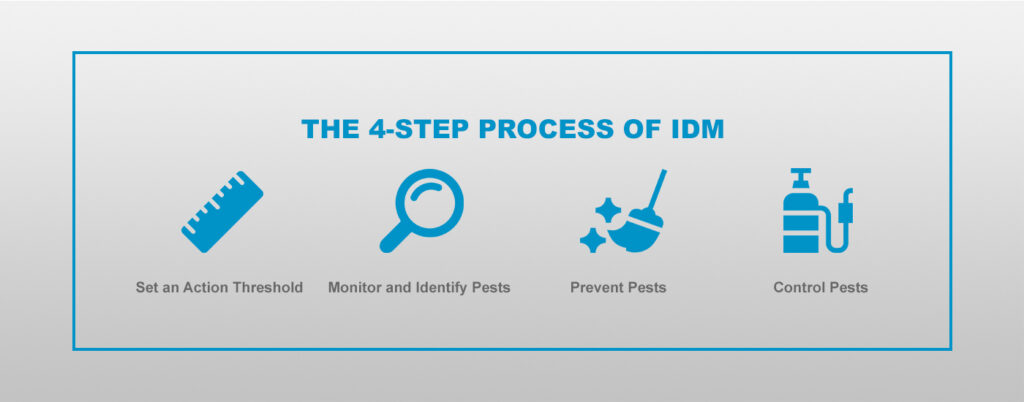
IPM is more than just one control method. Think of it as a number of pest control assessments, decisions and controls. This series of actions can be summarized in the following four steps:
1. Set an Action Threshold
Before it takes any action, IPM will first establish an action threshold. This threshold refers to the point at which environmental conditions or pest populations show that pest control is needed. If just one pest is spotted, this does not necessarily mean that extensive pest control action is required. The point at which the pest situation will become a threat economically is key to making pest control decisions in the future.
2. Monitor and Identify Pests
Not every bug, weed or living organism needs to be controlled when outside of a food service business. Many are actually harmless, with some even being helpful. IPM programs work to watch for pests and correctly identify them, which allows the right decisions to be made regarding pest control. Monitoring and identifying pests eliminates the chance of pesticides being used unnecessarily or inappropriately.
3. Prevent Pests
IPM programs also manage crops, lawns and indoor spaces to keep pests from becoming a threat in the first place. When it comes to agricultural crops, this could mean rotating between different crops, planting pest-free rootstock, picking pest-resistant crops and other cultural methods. These methods of pest control can be highly efficient, cost-effective and present little to no risk to humans and the environment.
4. Control Pests
Control steps are necessary once monitoring, identifying and the set action thresholds show there is a need for pest control action — and preventative practices are no longer available or working. IPM programs will then assess the appropriate method of control in terms of both effectiveness and potential risk. Pest controls that are effective and less risky are picked first, which includes weeding, trapping and using targeted chemicals like pheromones to disturb pest mating.
If additional monitoring, identifying and the set action thresholds show that these less risky methods are not effective, extra methods will be used, which include the targeted spraying of pesticides. As a last resort, IPM programs will use broadcast spraying of pesticides that are non-specific.
How IPM Equals Safety
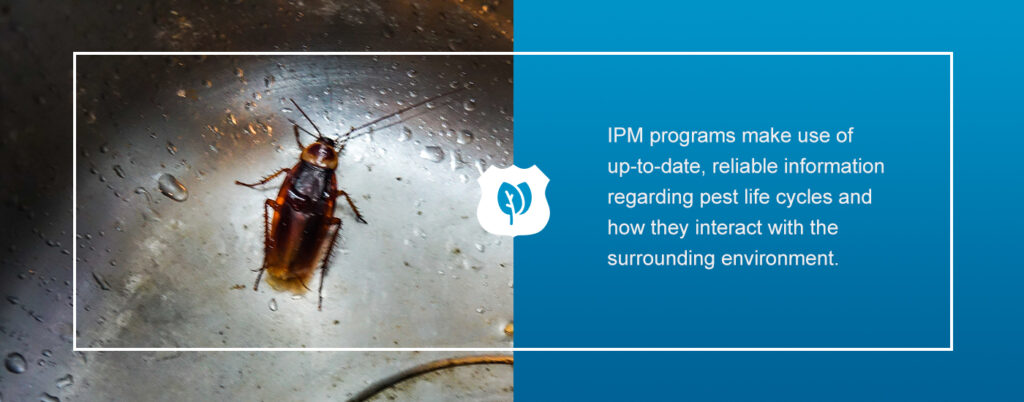
IPM is a comprehensive, scientifically well-informed approach that aims to minimize hazards to people, your property and the environment. IPM programs make use of up-to-date, reliable information regarding pest life cycles and how they interact with the surrounding environment. This information, combined with safe pest management practices, is used to control pest damage using the most economical, efficient and safest methods possible.
IPM’s approach can be used in both agricultural and non-agricultural settings, including the workplace, home and garden. One area that IPM takes especially seriously is pesticide use, limiting the use of pesticides to ones made from natural sources, not synthetic chemicals, whenever possible.
Food Safety Regulations
Food service businesses and agricultural organizations alike must follow food safety regulations. These standards apply specific rules to various industries about different topics, such as pest control. The most common food safety regulations are:
SQF
The Safe Quality Food (SQF) Program is administered by a worldwide association for food retailers known as the Food Marketing Institute. SQF combined its 1000 and 2000 codes into one single code for both food manufacturers and primary producers. There are modules for different industries, which were made to better reflect the Good Manufacturing and Agricultural Practices of the industry that’s being audited.
SQF’s pest control requirements are the same across all modules and tend to be less specific than BRC standards. You can learn more about SQF’s pest control standards here.
BRC
BRC standards were originally created for the British Retail Consortium (BRC), one of the UK’s major trade associations. BRC standards require senior management to assess the pest control program and put a strong emphasis on regular improvement. These standards specify many detailed requirements for quality management and Hazard Analysis and Critical Control Points (HACCP) systems. They include the most effective practices to make sure all businesses in the supply chain have fully implemented the systems to recognize and control hazards related to food safety.
AIB
The American Institute of Baking, known now as AIB International, strives to help food distributors and manufacturers better their quality management and food safety practices. Their international team of trainers, inspectors, scientists and bakers work closely with companies all over the world, applying technical expertise and in-depth knowledge.
Different Types of Food Facilities
Food service facilities that must follow food safety regulations and undergo health inspections generally include the following:
- Restaurants
- Meat markets and delis
- Food stands
- School cafeterias
- Pushcarts and mobile food units
- Elderly nutrition sites
- Institutional kitchens
- Temporary food service establishments
- Limited food service establishments
Pestech Can Help Your Food Facility
For over 30 years, we at Pestech Pest Solutions have been providing quick, efficient solutions for a variety of pest issues. If you’re dealing with pest problems — or just have a question related to food safety and pests — contact us or call us up at 1-800-287-2847.


